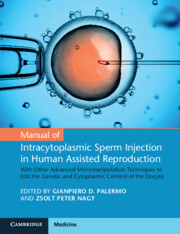 Manual of Intracytoplasmic Sperm Injection in Human Assisted Reproduction
Manual of Intracytoplasmic Sperm Injection in Human Assisted Reproduction Published online by Cambridge University Press: 02 December 2021
Interactions between the sperm-borne oocyte activating factor(s) (SOAF) and the molecules within the oocyte cytoplasm, trigger the molecular pathways associated with oocyte activation. Of note, release of calcium from the endoplasmic reticulum (ER) creates calcium oscillations in mammals and one large calcium release in non-mammalian species. As the newly activated ovum begins to transform, the components of the fertilizing spermatozoon function cooperatively with the contents of the ooplasm as development progresses. The spermatozoon has been shown to contribute the main microtubule framework to the embryo through the integration of its centriole and has also been implicated in facilitating processes. Through oocyte-driven mechanisms, unnecessary sperm components must also be degraded. Many of these processes are centered around the reducing power of oocyte-produced glutathione (GSH) and facilitated by both the sperm-borne and oocyte-borne enzymatic activity. In this chapter we explore underlying molecular and biochemical processes that drive developmental progression of newly fertilized oocytes, and how ICSI procedures could change the molecular pathways found in natural fertilization.
To save this book to your Kindle, first ensure [email protected] is added to your Approved Personal Document E-mail List under your Personal Document Settings on the Manage Your Content and Devices page of your Amazon account. Then enter the ‘name’ part of your Kindle email address below. Find out more about saving to your Kindle.
Note you can select to save to either the @free.kindle.com or @kindle.com variations. ‘@free.kindle.com’ emails are free but can only be saved to your device when it is connected to wi-fi. ‘@kindle.com’ emails can be delivered even when you are not connected to wi-fi, but note that service fees apply.
Find out more about the Kindle Personal Document Service.
To save content items to your account, please confirm that you agree to abide by our usage policies. If this is the first time you use this feature, you will be asked to authorise Cambridge Core to connect with your account. Find out more about saving content to Dropbox.
To save content items to your account, please confirm that you agree to abide by our usage policies. If this is the first time you use this feature, you will be asked to authorise Cambridge Core to connect with your account. Find out more about saving content to Google Drive.